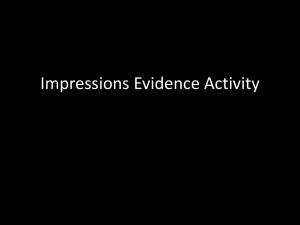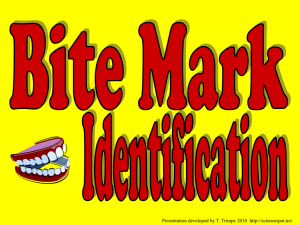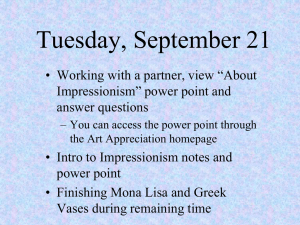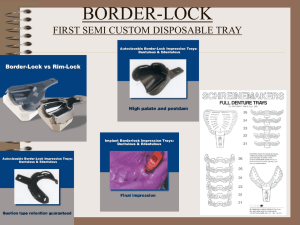An accurate and detailed impression of the prepared tooth is an
advertisement
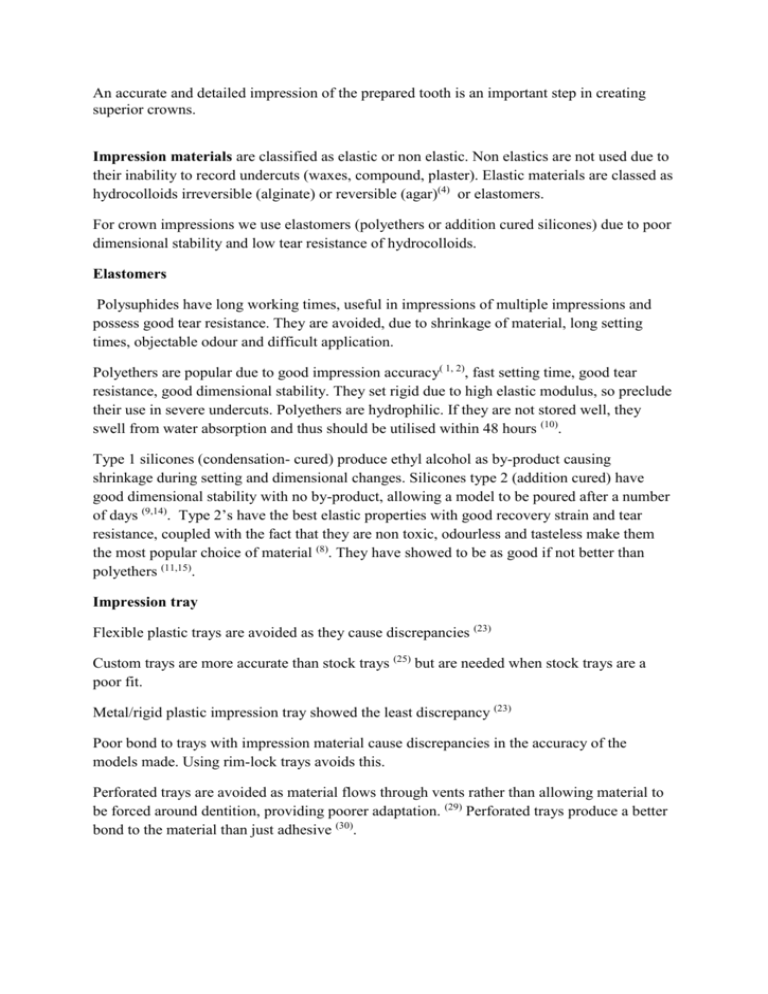
An accurate and detailed impression of the prepared tooth is an important step in creating superior crowns. Impression materials are classified as elastic or non elastic. Non elastics are not used due to their inability to record undercuts (waxes, compound, plaster). Elastic materials are classed as hydrocolloids irreversible (alginate) or reversible (agar)(4) or elastomers. For crown impressions we use elastomers (polyethers or addition cured silicones) due to poor dimensional stability and low tear resistance of hydrocolloids. Elastomers Polysuphides have long working times, useful in impressions of multiple impressions and possess good tear resistance. They are avoided, due to shrinkage of material, long setting times, objectable odour and difficult application. Polyethers are popular due to good impression accuracy( 1, 2), fast setting time, good tear resistance, good dimensional stability. They set rigid due to high elastic modulus, so preclude their use in severe undercuts. Polyethers are hydrophilic. If they are not stored well, they swell from water absorption and thus should be utilised within 48 hours (10). Type 1 silicones (condensation- cured) produce ethyl alcohol as by-product causing shrinkage during setting and dimensional changes. Silicones type 2 (addition cured) have good dimensional stability with no by-product, allowing a model to be poured after a number of days (9,14). Type 2’s have the best elastic properties with good recovery strain and tear resistance, coupled with the fact that they are non toxic, odourless and tasteless make them the most popular choice of material (8). They have showed to be as good if not better than polyethers (11,15). Impression tray Flexible plastic trays are avoided as they cause discrepancies (23) Custom trays are more accurate than stock trays (25) but are needed when stock trays are a poor fit. Metal/rigid plastic impression tray showed the least discrepancy (23) Poor bond to trays with impression material cause discrepancies in the accuracy of the models made. Using rim-lock trays avoids this. Perforated trays are avoided as material flows through vents rather than allowing material to be forced around dentition, providing poorer adaptation. (29) Perforated trays produce a better bond to the material than just adhesive (30). The most important factor, rather than tray or impression material is technique (6, 7). Techniques include: 1 stage impression- putty and wash record the preparation simultaneously. 2 stage impression- putty records the preparation first then allowed to set then relined with the wash for a second impression. 2 stage spaced- same for the 2 stage but space is created for the wash. Due to recoil and difficulty reseating the putty, 2 stage techniques are not recommended (32, 33) Dual arch trays record the preparations, the opposing arch and the registration all in one. It has been reported to be a good technique providing reasonable accuracy (24). CadCam uses computer technology to scan the preparation and then mills the restoration from ceramic blocks . It has been found accurate (46), but has limitations on cost (47). Material is hand mixed or syringe mixed. Syringe mixing reduces air bubbles, more homogenous mix as correct proportions and reduces mixing time. Gingival Retraction Equigingival/Subgingival margins need some type of soft tissue retraction for good impressions to allow material to capture the finishing line detail. Retraction cord technique- Placing single cord within the gingival sulcus for retraction. The 2 cord technique- Placing thin cord, then thicker cord. After retraction, the thicker cord is removed and impression taken leaving the thinner cord. Trauma and recession can occur (31), but allows sufficient bulk of impression material and controls haemorrhage. Chemicals- Soaking cord with chemicals, can increase retraction. Concerns are changes in respiratory and heart rate occurs (34) (epinephrine), tissue necrosis(35) (aluminium chloride) and gingival stains (ferric sulphate). Cordless chemical retraction- using aluminium chloride is Expasyl. Causes retraction and haemostasis without tissue damage as seen with cord (36) but induces sensitivity reactions (37). Expasyl is pushed into sulcus and allowed time for effect, then washed away leaving retracted gingivae. Curettage uses burs, electrosurgery and lasers, to create a trough around the finishing margins of the preparation when subgingival, causing pain and bleeding thus requires a haemostatic agent (ferric sulphate). Studies show no histological change between rotary and cord (39). Electrosurgery is modified cautery, using electricity through a cutting electrode to create the trough. Studies showed no difference between rotary and electrosurgery(38) but it is unpredictable (40), causes tissue damage and avoided in patients with pacemakers. Lasers can be used with little or no anaesthetic and have faster gingival healing rates with less bleeding (41, 42, 43). The copper band technique- A copper band is placed around tooth margin, this retracts soft tissue. Impression material is then filled into the band (26, 27, 28). They are cheap, accurate, easily available but can traumatise the gingivae. General Considerations Poor manual dexterity, Patients with severe gag contribute to poor impressions. Patients with severe undercuts (gingival or tooth preparation) cause recoil of the material and distortion. Others considerations :- Uninhibited Material 1 Gloves containing sulphur to mix or handling retraction cord (45). 2 Temporary crown residues that come in contact with type 2 silicones which affect setting and detail of the impression (12). 3 Poor material mix (13). Poor Detail 1 Material stored in too high/low temperature (16,17,18). 2 Heavy-body with little flow displacing light body from preparation. 3 Disinfection by materials which affect surface detail (21). 4 Debris/saliva/blood present during impression. Drags 1 Poor material mix by machine/hand (13). 2 Area excessively moist causing hydrophobic materials to be repelled away 3 Saliva/debris contamination. 4 Poorly adapted tray. 5 Light body setting before the seating tray. Margin voids 1 Air trapped in syringe tips (44). 2 Air trapped while filling material in tray. 3 Inadequate coverage of light body. 4 Blood/saliva around prep. 5 Exceeding working time so poor flow. 6 Impression material stored at elevated temperature. Delamination Exceeding the working time(19, 20). Tray to tooth contact 1 Improper tray placement. 2 Incorrect tray size/adaptation. 3 Inadequate material amount. Tearing at preparation margin 1 Inadequate/unset material mix. 2 Material out of date. 3 Insufficient gingival retraction. 4 Retracton cord with ph <5, or contains sulphur. References 1. Impression Accuracy when Recording Impressions of Moist Surfaces J. MCCABE, and T. CARRICK, University of Newcastle upon Tyne, England, Uk 2. Detail Reproduction of Impression Materials on a Wet Surface R. PERRY, G. KUGEL, E. APPELIN, and B. GREEN, Tufts University, Boston, MA, USA 3.Ensuring Accuracy and Predictability With Double-Arch Impressions Gordon J. Christensen, DDS, MSD, PhD 4. Clinical evaluation of agar alginate combined impression P. Manorika Ratnaweera J Med Dent Sci 2003 5.Accuracy of elastomeric impressions disinfected by immersion Authors: G H Johnson, D G Drennon, G L Powell Journal of the American Dental Association 6. Influence of the type of impression material, impression tray and making impression technology on the dimensional accuracy and depth of impression material penetration into "gingival sulcus". In vitro study Authors: A N Riakhovskiĭ, M A Muradov Journal: Stomatologiia 7. Wettability and accuracy of reproduction of impression materials Authors: F Bader, J Setz Journal: Deutsche zahnärztliche Zeitschrift 8. Journal: Australian Dental Journal review of modern impression materials Authors: J K Harcourt 9 Evaluation of accuracy and the time-dependent dimensional stability of silicone based impression materials Authors: H Yavuzyilmaz, C Dinçer, L Nalbant Journal: Ankara Üniversitesi Diş Hekimliği Fakültesi dergisi = The Journal of the Dental Faculty of Ankara University 10. Dimensional accuracy of a new polyether impression material Authors: Tatsuo Endo, Werner J Finger Impact factor: 0.73, Cited half life: >10.0, Immediacy index: 0.06 Journal: Quintessence international 11. Accuracy of alginate and elastomeric impression materials Authors: A Peutzfeldt, E Asmussen Journal: Scandinavian journal of dental research 12. Polyvinyl siloxane impression materials: a review of properties and techniques Authors: W W Chee, T E Donovan Impact factor: 1.01, Cited half life: >10.0, Immediacy index: 0.07 Journal: Journal of Prosthetic Dentistry 13. Dimensional stability of two impression materials Authors: C L Chew Impact factor: 0.73, Cited half life: 7.2, Immediacy index: 0.32 Journal: Annals of the Academy of Medicine, Singapore 14. Clinically oriented evaluation of the accuracy of commonly used impression materials Authors: A H Tjan, S B Whang, A H Tjan, R Sarkissian Impact factor: 1.01, Cited half life: >10.0, Immediacy index: 0.07 Journal: Journal of Prosthetic Dentistry 15. Factors affecting the accuracy of elastometric impression materials Authors: S Y Chen, W M Liang, F N Chen Impact factor: 2, Cited half life: 7.8, Immediacy index: 0.22 Journal: Journal of Dentistry 16. The effect of temperature changes on the dimensional stability of polyvinyl siloxane and polyether impression materials Authors: M Corso, A Abanomy, J Di Canzio, D Zurakowski, S M Morgano Impact factor: 1.01, Cited half life: >10.0, Immediacy index: 0.07 Journal: Journal of Prosthetic Dentistry 17. Temperature effects on the rheological properties of current polyether and polysiloxane impression materials during setting Authors: John C Berg, Glen H Johnson, Xavier Lepe, Sergio Adán-Plaza Impact factor: 1.01, Cited half life: >10.0, Immediacy index: 0.07 Journal: Journal of Prosthetic Dentistry 18. Dimensional changes of dental impression materials by thermal changes Authors: K M Kim, J S Lee, K N Kim, S W Shin Journal: Journal of Biomedical Materials Research 19. Working time of elastomeric impression materials: relevance of rheological tests Authors: Markus Balkenhol, Masafumi Kanehira, Werner J Finger, Bernd Wöstmann Impact factor: 1.28, Cited half life: 7.1, Immediacy index: 0.18 Journal: American journal of dentistry 20. Working time of synthetic elastomeric impression material Authors: R J McConnell, L N Johnson, D R Gratton Journal: Journal (Canadian Dental Association 21. Three-dimensional investigation of the accuracy of impression materials after disinfection Authors: M Kern, R M Rathmer, J R Strub Impact factor: 1.01, Cited half life: >10.0, Immediacy index: 0.07 Journal: Journal of Prosthetic Dentistry 22. The dimensional stability of elastomeric impression materials following disinfection Authors: E M Langenwalter, S A Aquilino, K A Turner Impact factor: 1.01, Cited half life: >10.0, Immediacy index: 0.07 Journal: Journal of Prosthetic Dentistry 23. BDJ influence of the impression tray on the accuracy of impressions for crown and bridge work-an investigation and review. Carrotte PV, Johnson A, Winstanley RB. 24. AJD Davis RD Schwartz, RS. Dual-arch and custom tray impression accuracy 25. Oral Rehabil. 1998 Aug;25 Determining the accuracy of stock and custom tray impression/casts Millstein P, Maya A, Segura C. 26. Shillingburg. Fluid control and soft tissue management. 27. Copper-band impressions for complete crown abutments Authors: J Orstavik Journal: Journal of Prosthetic Dentistry 28. Copper-band gingival retraction to produce void-free crown and bridge impressions Authors: H Darby, L H Darby Journal: Journal of Prosthetic Dentistry 29. http://www.greatlakesortho.com/content/files/resources/ImpressionandWorkModelInstr_S21 8.pdf 30. J Can Dent Assoc. 1991 Aug Peel bond strengths of 5 impression material tray adhesives MacSween R, Price RB. 31. Dent Today Using Double cord Packing Technique Cloyd S 1999 32. The Accuracy of Pvs impressions made with standard reinforced stock trays 1991 jprostheticDent. 33. An update on elastomeric impression materials bdj 1981 Brown D 34. review and survey of medicants used in with gingival retraction cords Jprosth Dent 1985 35. Retraction cords with aluminium chloride : effect on the gingivae Operative Dent 1980 36. Haemostatic agents used in periradicular surgery: an experimental study of their efficacy and tissue reactions Authors: T von Arx, S S Jensen, S Hänni, R K Schenk International endodontic journal 37. Clinical study on the effects of cordless and conventional retraction techniques on the gingival and periodontal health. Authors: Khaled Q Al Hamad, Wesam Z Azar, Hayder A Alwaeli, Khalid N Said Journal of clinical periodontology 38. DeVitre R, Galburt RB, Maness WJ. Biometric comparison of bur and electrosurgical retraction methods. J Prosthet Dent. 1985;53(2):179–182. 39. Tupac a comparison of cord gingival displacement with gingitage j prosth dent 1981 40. Coelho DH, Cavallars J, Rothschild EA. Gingival recession with electrosurgery for impression making. J Prosthet Dent. 1975;33( 41. Scott A. Use of an erbium laser in lieu of retraction cord: a modern technique. Gen Dent. 2005;53(2):116 42. Passes H, Furman M, Rosenfeld D, Jurim A. A case study of lasers in cosmetic dentistry. Curr Opin Cosmet Dent. 1995; 43. Abdel Gabbar F, Aboulazm SF. Comparative study on gingival retraction using mechanochemical procedure and pulsed Nd = YAG laser irradiation. Egypt Dent J. 1995; 44. Chong YH porosities in 5 automixed addition silicone elastomers operative dent 1991 45. Baumann A influence of dental gloves on the setting of impression materials BDJ 1995 46. Journal of Oral Rehab Marginal and internal fit of all-ceramic CAD/CAM crown-copings on chamfer preparations A. BINDL & W. H. MÖRMANN 47. Journal of Indian Prosthodontic Society Unconventional prosthodontics: Post, core and crown technique Murali Srinivasan





